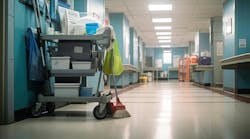In 1956, a quote frequently attributed to management guru Peter Drucker declared, “If you can't measure it, you can't manage it.” Author V. F. Ridgway soon responded in an academic journal that this measurement mantra was too simplistic: “Not everything that matters can be measured. Not everything that we can measure matters.”
In custodial services for education institutions, some measurements actually do matter. Here are key performance indicators that school and university custodial managers should consider to objectively measure cleaning performance.
Routine surface cleaning
Far too often, cleaning performance is determined by meeting task and frequency requirements and using only visual inspection to measure performance. But this is woefully limiting because it is often the things we cannot see such as viruses, bacteria, spores, dust contaminated with pesticides, insect droppings, and other contaminants that pose threats to health.
To help measure what matters, ATP (Adenosine Triphosphate) meters can objectively measure contaminants on the surface. The U.S. Green Building Council has developed a resource guide for using ATP meters and other devices. This guide brings ATP meters out of hospitals and food processing facilities and into custodial operations in a way that is meaningful, easy to use and cost-effective.
Changing mop bucket water
The traditional approach to changing mop bucket water is based on replenishment after a set number of rooms, when it “looks dirty” or “smells bad. The decision has little to do with the actual level of soil in the water. When water is dirty, cleaning personnel are just spreading contaminants.
To help measure what matters, turbidity meters are routinely used for monitoring water quality and can be adapted for custodial operations to objectively determine when mop bucket water needs to be replenished.
Dilution of concentrated disinfectants
Disinfectants help protect health; using concentrates that are diluted on site reduces costs and environmental impacts. Unfortunately, some dilution control devices may be extremely inaccurate, and the resulting solution may not have enough active ingredients to effectively perform against pathogens. Or, if too much concentrate is used, disinfectants are wasted and the risk of health and environmental impacts increases.
To help measure what matters, inexpensive test strips are readily available that determine the concentration of active ingredients in common disinfectants such as quats, chlorine and hydrogen peroxide. These test strips are easy to use and inexpensive (under 5 cents each). Considering the important role that disinfectants have in protecting student and staff health, school custodians should be objectively measuring the amount of active ingredients in these products.
Slippery floors
According to the Consumer Product Safety Commission, floors and flooring materials contribute directly to more than 2 million falls each year that result in injuries. Although slips and falls do not constitute a primary cause of fatal injuries, they do represent the primary cause of lost days from work and unnecessary injuries and liabilities.
To help measure what matters, coefficient-of-slip devices can objectively measure the conditions of floors to protect occupant health and reduce liability. These devices should be moved out of the laboratory and used in facilities where they can identify potential slipping problems, such as flooring material or floor coating; or slipperiness because of excessive detergent residue, moisture, dust, or ice melt.
These four objective measurement tools can help schools and universities measure and manage those things that are meaningful, as well as easy and cost-effective.


